Way back in November, 2016 I did a post about cleaning vintage linens and as I continue to experiment with these treasures, my methods evolve. I’ve gotten very simple and straight forward by cutting my supplies down to 2 ingredients: water and automatic dish powder. (The dish detergent we used to put in our Dishwashers until the handy “tabs” were invented.)
***For an updated post about my methods scroll to: 07-23-2021.
***Warning! Do not use this soak method if your piece has either black or dark grey embroidery floss!! If you have either of these two colors of floss just rely on either Biz or Oxyclean. Follow the instructions on the product container with care!
***Update: recipe is approx. 1 cup automatic dish powder to approx. 2 gallons warm tap water.
In the past I always purchased Cascade powder but one day at Kroger I saw their house brand at less than half the cost. After using the generic powder very successfully, my purchasing habit changed! In the pic below I don’t remember if this is a Kroger or a Walmart generic brand. ***Update: thanks to Stephanie, this automatic dish powder is from Kroger, she just purchased some and is currently soaking some of her vintage linens and in her words: “the water is yucky!”
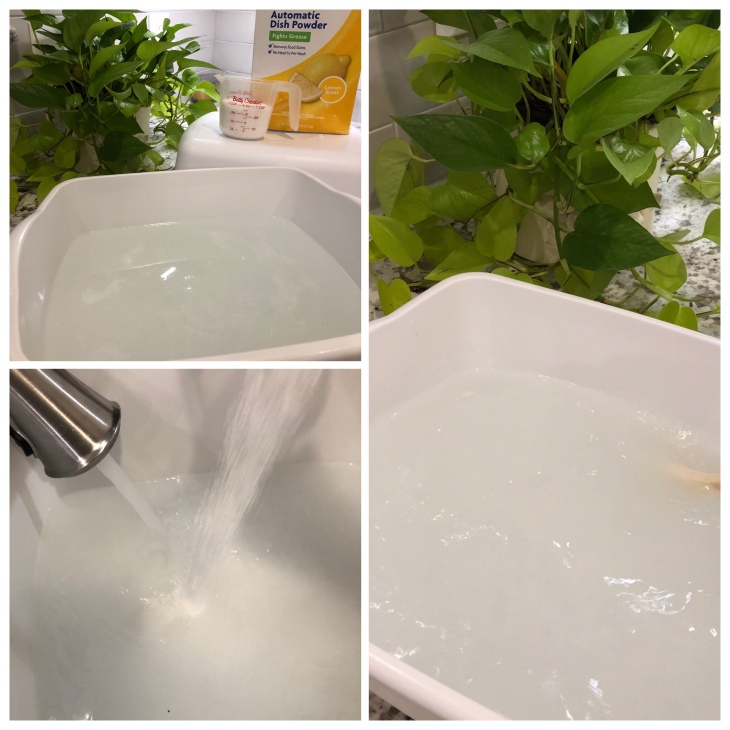
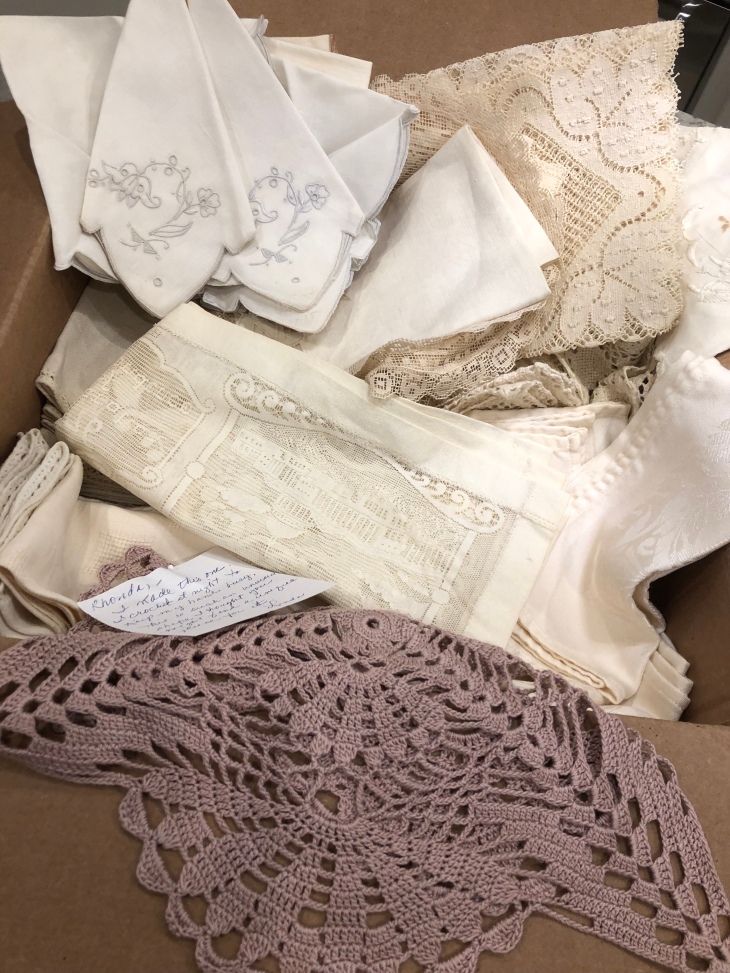
I spoke to the awesome McKinney (Texas) Quilt Guild in April of this year and yesterday a box of amazing treasures arrived at my door step. Thank you Linda R.!! She crocheted the beautiful piece above! The other pieces, all vintage, were from her neighbor. As with most all linens, these showed the results of being loved and used for the purpose of which they were created.

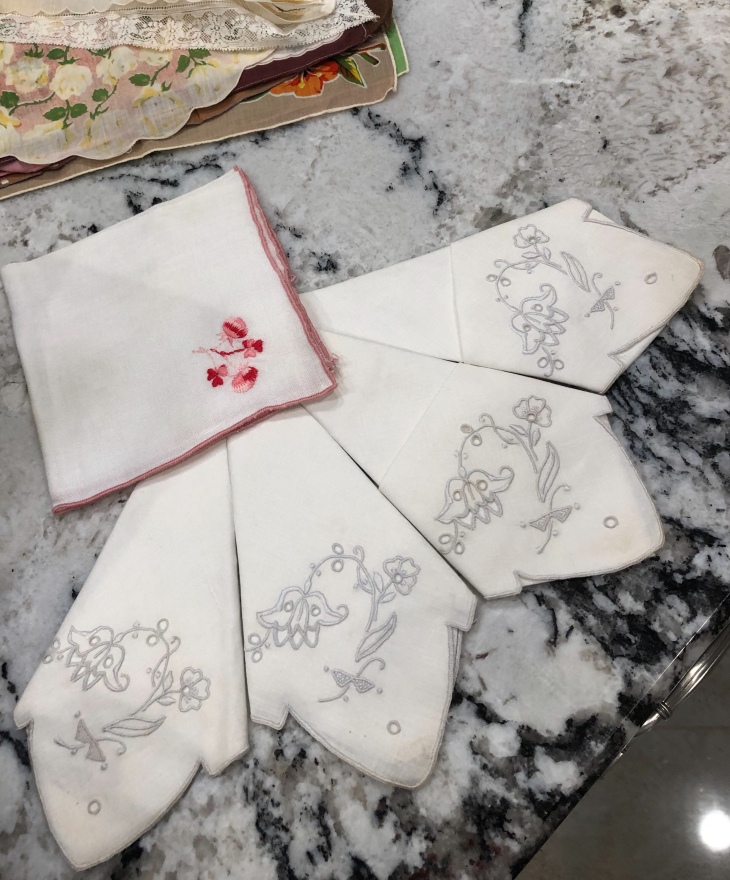
Oh be still my heart, the things in this box are just wonderful!
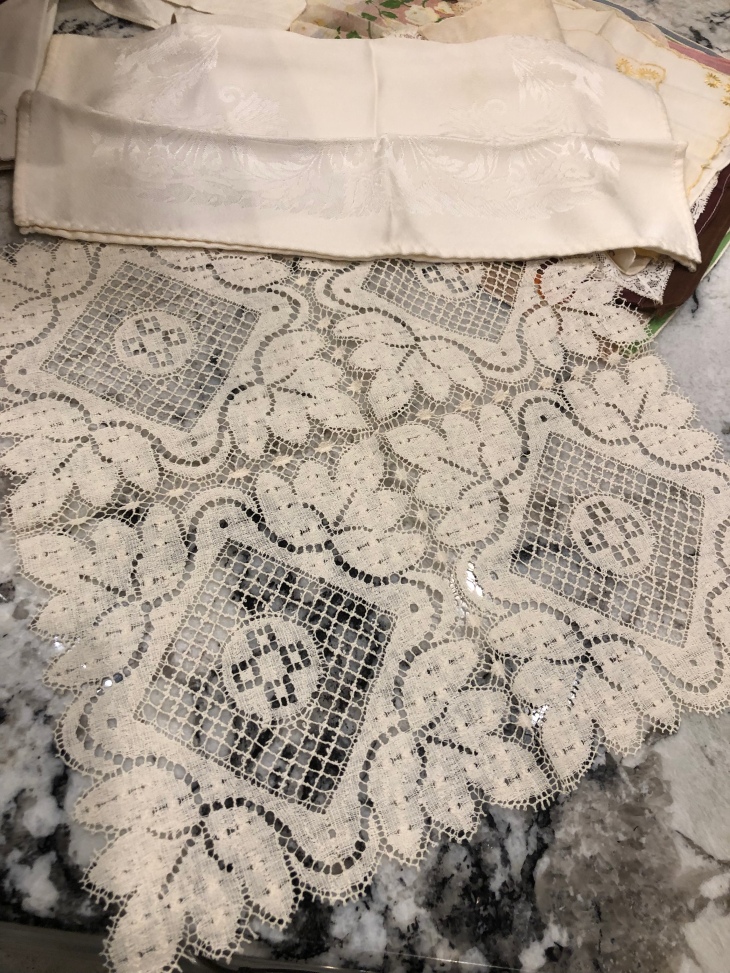
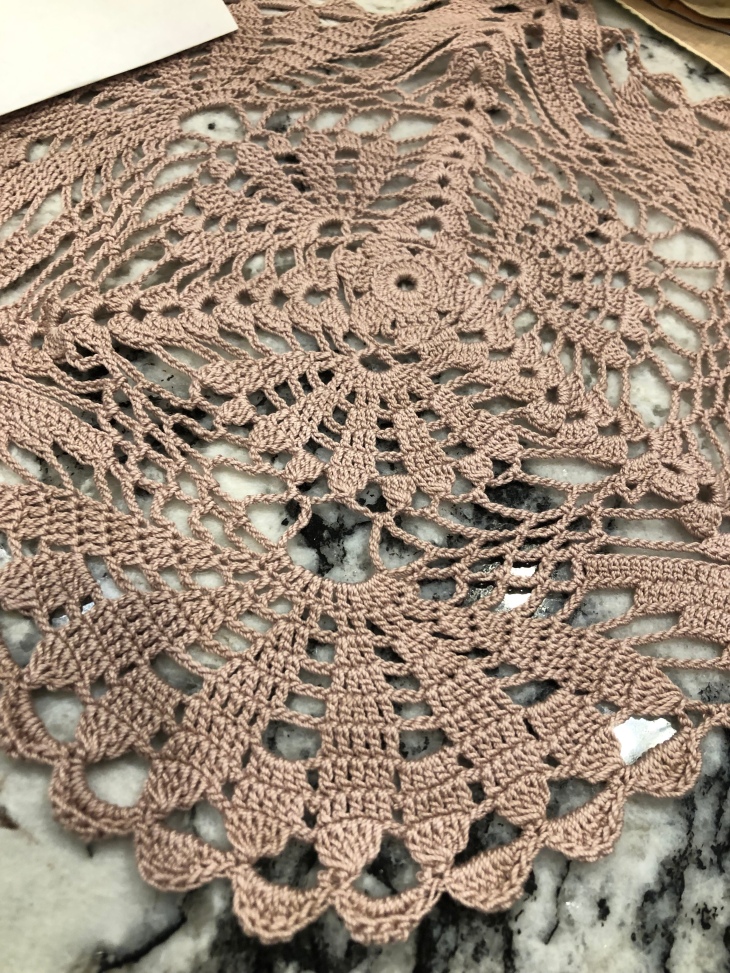
Isn’t the above piece simply beautiful!!


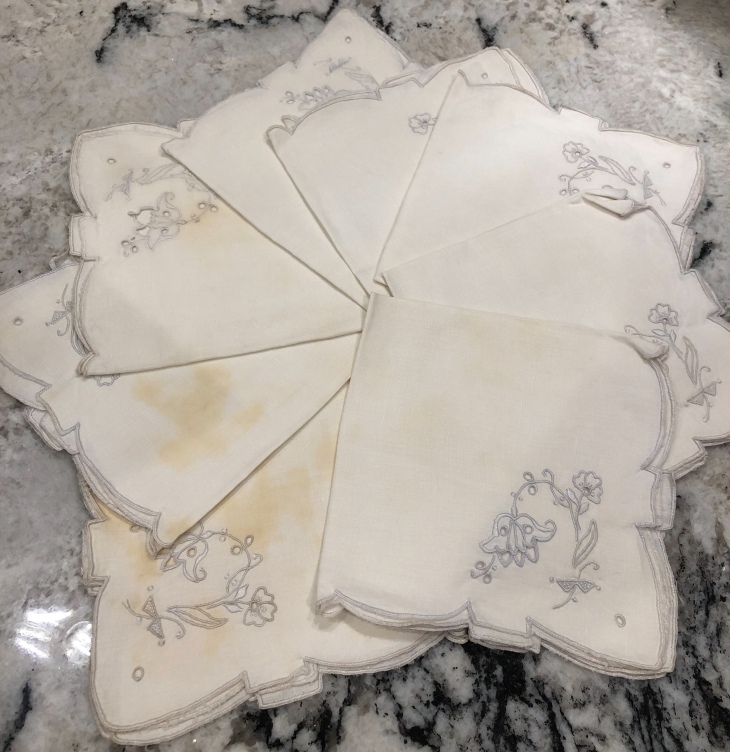
So what’s up with the safety pin in the napkin below? I chose the napkin (from the matching set of 8) showing the most staining and by pinning it I can find it again and compare the end results with what the piece looked like at the beginning.
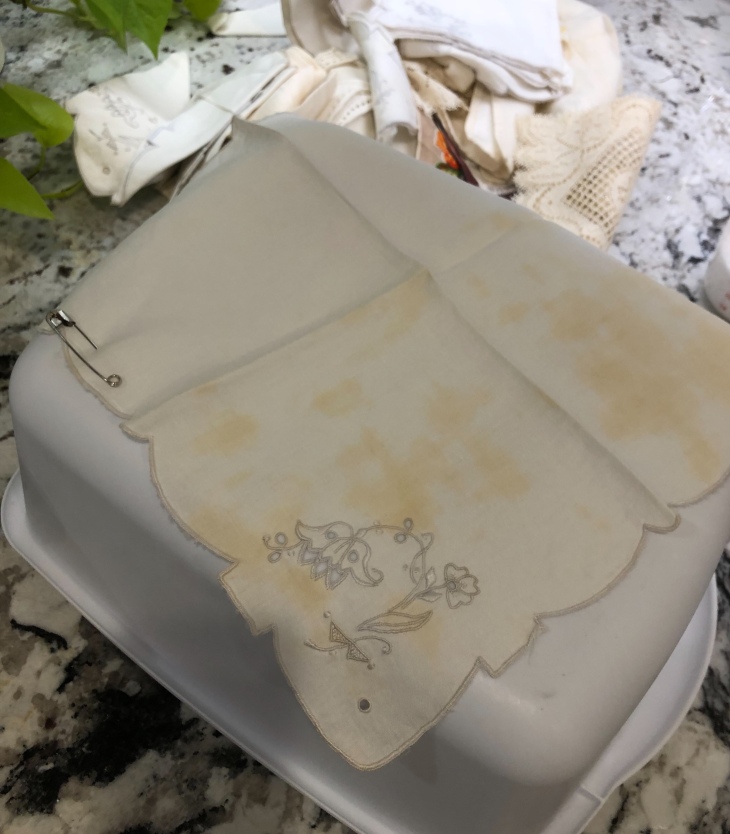
In 2 minutes time can you believe the change in the soak water!
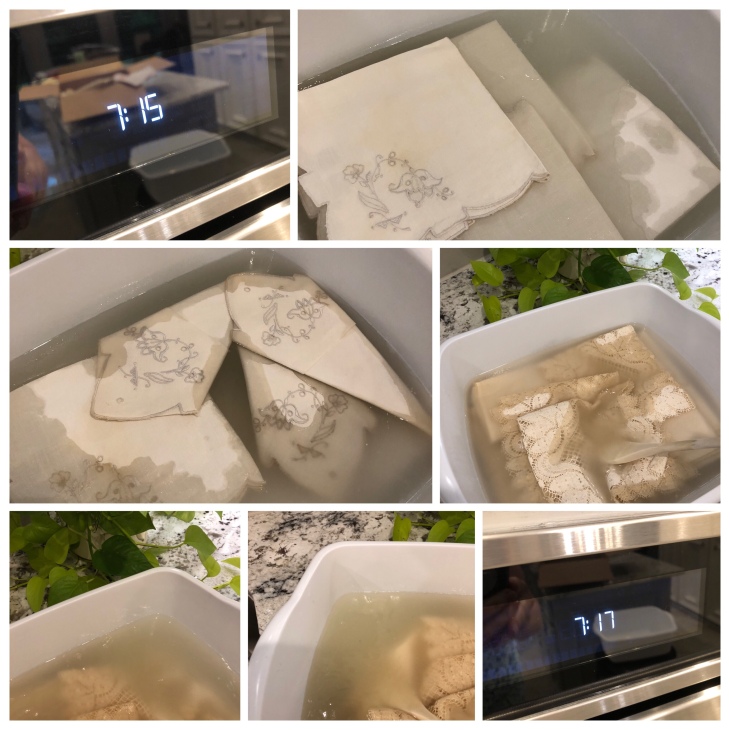
Again, in soak container #2, the 1 minute change from clear to horrible looking water:
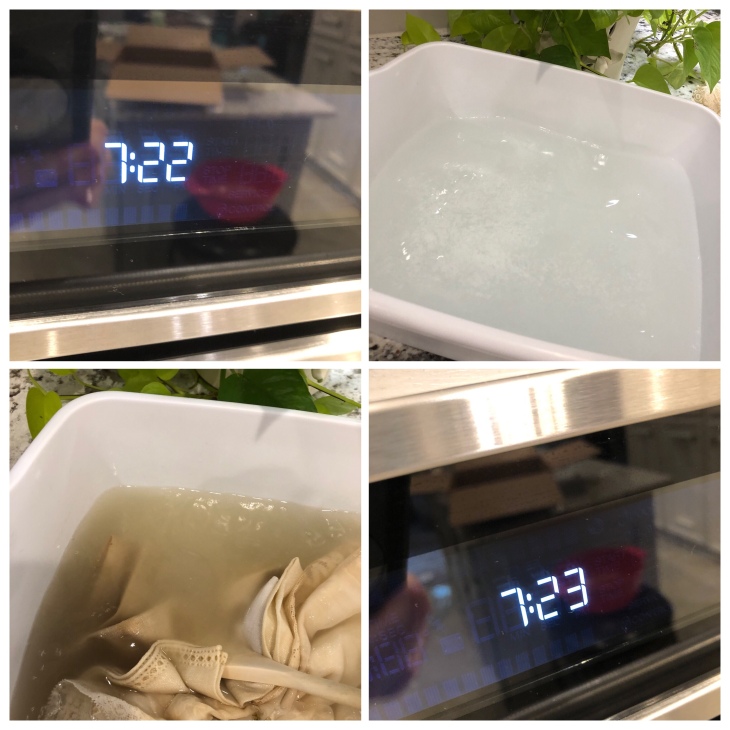

Included in the Treasure Box was this wonderful napkin keeper shown above. Laid out flat it it resembles a giant + sign. Can you see the tiny snaps? Once the napkins (or handkerchiefs) are cleaned, they are folded and stacked lying atop the center square. The side flaps are then folded in and snapped accordingly. Finally the top and bottom flaps are folded in and snapped revealing the beautiful monogram in the center:
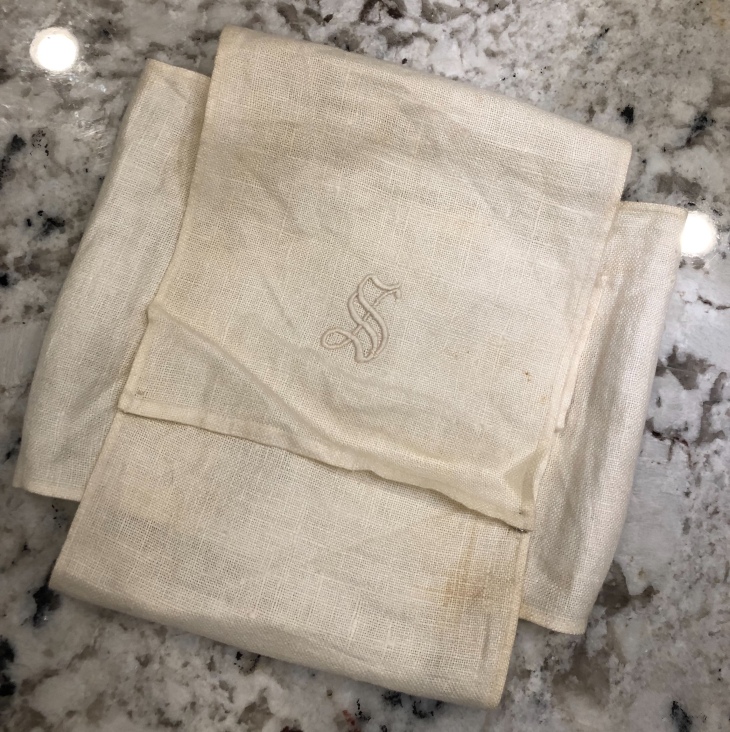
I am always fascinated by the color of the soak water. The automatic dish powder is removing among other things: laundry soap residue, dust, hand oils, ironing starches and embedded food/beverage residue/stains. Some stains that the laundry powder cannot remove: the dreaded Rust, some lipsticks, nail polish and occasionally some perfume stains. Use caution when attempting to remove rust as it has already penetrated and has begun to destroy the fibers around it. Personally I’ve learned the hard way to just leave rust alone and in a project I will position a “distractor” of some sort over a rust spot.
Here are the 2 soaking bins after about 15 minutes. I will let these pieces stay in the water about 24 hours. Because the soak solution is so concentrated, the pieces will require a great deal of rinsing. When you think you’ve rinsed enough, do it one more time but add 1/2 to 1 cup of clear (distilled) vinegar to the rinse water to remove any remaining soap residue. Your pieces, when dry, may retain the aroma of vinegar for a day or two but this will dissipate.


These beautiful ladies handkerchiefs were also in the Treasure Box. I will soak them at a later date.
I will do an additional blog about how these vintage pieces turned out once they are finished soaking, rinsed, dried and pressed! Stay tuned…
Hope you’ve enjoyed this blog post, let me know if you have questions!
Blessings for a wonderful day!
Rhonda
***someone pointed out to me that my Pinterest address on my business card is wrong 🙁
If you want to find me on Pinterest just type in my first and last name in the search bar. I checked and there’s no other Rhonda Dort listed, an advantage of having an unusual last name 😎
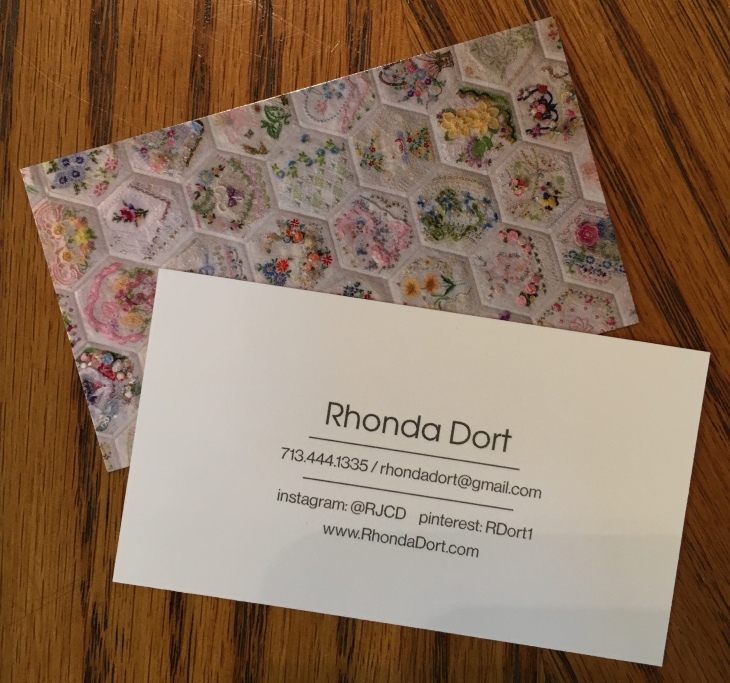

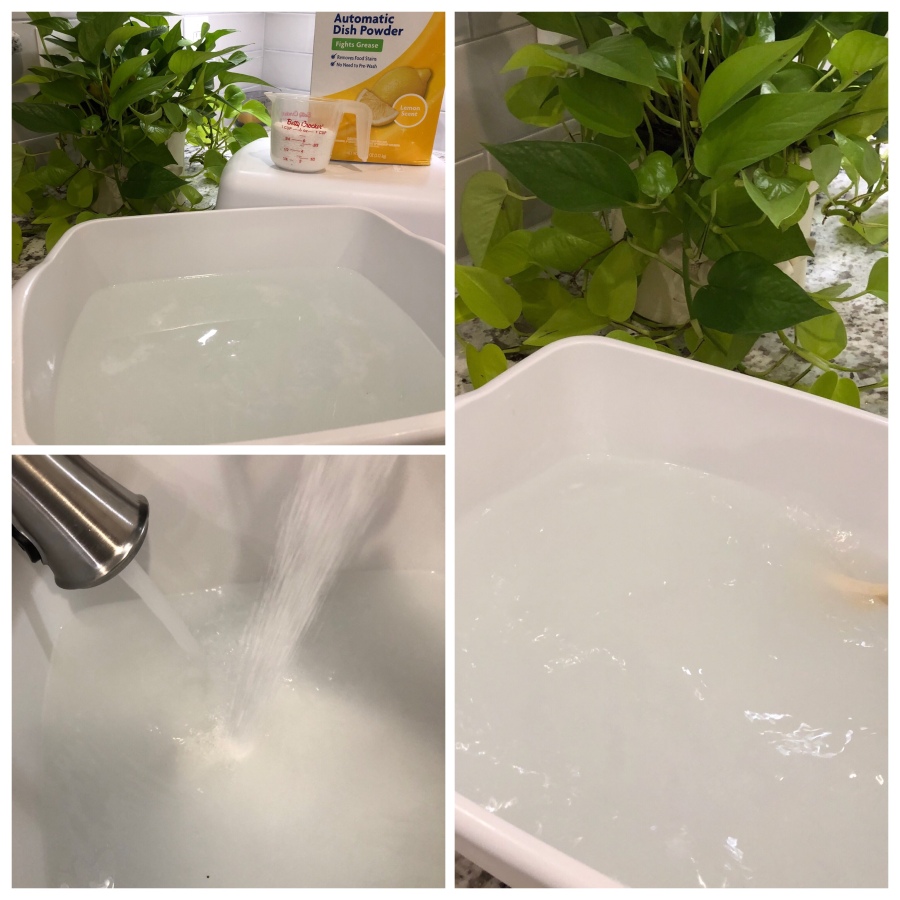
Love this blog. It was very timely. I will be able to save all my Gram & Aunties beautiful work. Thank you so much Rhonda!
LikeLiked by 1 person
❤️ Great! Thank you for your kind words!
LikeLike
Hi,
May I ask, do you know how to get strong mildew, possibly mold smell out of old quilts? Thank you for any information you may have.
LikeLiked by 1 person
Yes! Many people have had success getting rid of mildew/mold with ammonia. If I were you, I would Google: fabric, mold, mildew ammonia, and see what kind of results you get.
LikeLike
I’ve used a cup of baking soda with success.
LikeLiked by 1 person
Tell me more…baking soda in water to make a paste? I’m intrigued!
LikeLike
When I bring home fabric that doesn’t smell just right, I put 1/2-1c. dry baking soda in my front loader washer depending on size of load.
LikeLiked by 1 person
When I bring fabric home that doesn’t smell just right, I put 1/2-1 cup of dry baking soda in my front loader washer. The amount depends on the load size.
LikeLiked by 1 person
I have a dresser scarf that had 2 big brown rings on it. Soaked twice in dishwasher powder overnight and it was amazing! Instant dark brown water. After soaking and rinsing the stains are almost gone; only faint yellowish rings remain. Will additional soaks help or should I try an alternative like Biz?
LikeLiked by 1 person
I usually soak thinks 24-36 hours. If you’ve soaked twice it might be a great idea to give the Biz a try! Keep me posted!
LikeLike
Thank you. The original soaks were 24 hours, the next batch of linens will go 36. I was so excited I couldn’t wait 😄. The same length for the Biz soak?
LikeLiked by 1 person
Yes, and I know what you mean about getting excited about soaking things, and having the water turned horrible, knowing the whole time that that is an indication of all of the stains in any given item!
LikeLike
I wish there was an after picture. So we could see the beautiful restored linens.
LikeLiked by 1 person
I have been downsizing our home and came across table scarves, hand crocheted doilies, and table linens that had been stored for 60 plus years and they had many stains and were deeply yellowed. They were made by my mother, her grandmother, and my father’s mother so they had special meaning to me. I followed your recommendations and the dishwashing detergent worked miracles. They look beautiful and now I am proud to give them to my family. Thank you for sharing your wisdom and talent here.
LikeLiked by 1 person
Wonderful!! Thanks for letting me know that you had a success! That makes me smile!
LikeLike
Will you ever see this reply??? I don’t know but, I need to tell you how awesome it is that you have gone to this degree to send tangible love to family members. ❤️❤️❤️
LikeLiked by 1 person
Rhonda this how to clean vintage is wonderful to read. I just received a crocheted bedspread in that thin thread you make dolies with its white and has green thread around a white flower in the middle of each triangle. So beautiful and it 100 years old to be passed down the family line. It has some yellow areas. What should I do. Don’t want to ruin this labor of love made by my Great Grandmother please help.
LikeLiked by 1 person
I think if you read and follow the recommendations in the following blog post you could very well be successful!
https://rhondadort.com/2021/07/
LikeLike
Rhonda, Thank you for sharing your cleaning method. Next time I’m at a garage sale I won’t pass up the stained table clothes. This is so simple and easy. Nancy
LikeLiked by 1 person
Hi Rhonda I just read your cleaning method I can’t wait to use this on my vintage pices, I have my grandmother’s doilies and a beautiful embroidery table cloth with stains. All so precious to me. I have some handkerchiefs that’s were mind when I was a child, I want my granddaughter to have , I hope I get to see your method on that one. Thanks so much for sharing your knowledge with everyone.
LikeLiked by 1 person
Wonderful! Hope it works well for you!
LikeLike
Hello Rhonda, regarding rust stains, I found a wonderful rust remover on Ebay (UK) some years ago, which works brilliantly. You only need a drop for most stains. Obviously it contains chemicals, and the instructions say to rinse the fabric thoroughly after use. Presumably Ebay (USA) might have some listed.
LikeLiked by 1 person
Do you think liquid dishwasher detergent will work?
LikeLiked by 1 person
I think you should compare ingredients, even if you have to go to the manufacturers web site. You also need to be concerned about the coloring of the dishwasher liquid, will it tint and or stain your fabrics? I wouldn’t use it but there’s no harm in experimenting if it’s something you don’t mind ruining??
LikeLike
Thank you for your advice, I think I’ll just go get the powder instead.
LikeLiked by 1 person
Impressive. More than restoring the whites is the part about sharing these linens and preserving vintage items.
Word of caution: American cotton can be bleached, boiled and dyed. Never bleach foreign cotton. It will turn orange. Look at the labels in your clothing. Some even say not to use detergent that is peroxide based.
LikeLiked by 1 person
Thank you for this post. I have some old linens that have been purposely dyed with tea. Will this remove the tea dying?
LikeLiked by 1 person
I believe that you might be very successful in removing the tea from the Vintage Linens. The issue that you’re going to have to deal with might be that the chemicals in tea tend to damage and or weaken fibers so treat your linens very very carefully and maybe start with a soak that might not be longer than six or seven hours. It may take you several soaks to remove the amount of tea from your pieces. Best of luck and keep me posted if you would!
LikeLike
I’m so excited to try your method. I was given 2 boxes full of my 98 year old neighbors linen. She said most belonged to her mother when she was young, so passed to her. The lace table cloth is beautiful. And I see a hand towel with Initials on it just like the one above. I’m so happy I came across your page. Now to find the power to do the process. Wish me luck! Can’t wait to see what I have…
LikeLiked by 1 person
I wish I would have taken before and after pictures!!! I can’t thank you enough for this post! My pieces were, literally, brown with dirt, stains, and all of the stains were OLD. Holy cow! I can’t wait to start using the table cloths now that they don’t have old, yellow stains all over them. THANK YOU!!
LikeLiked by 1 person
Wonderful!!! Thanks for your comment, so glad your things are clean and stain free!
LikeLike
I completely forgot to update you on the rug! It turned out awesome! Went from brown to very colorful. The lady I was fixing it for couldnt believe how clean it got. Her sister didnt even recognise it when she saw it! Thank you so much for your help!
LikeLiked by 1 person
Well how great is this! You must have been as thrilled as the person you were helping! Congrats!!
LikeLike
I am going to soak an old quilt to clean it. How do you recommend drying it? It’ll be so heavy!
LikeLiked by 1 person
Jennifer, have you read my blog post of July, 2021? In it I specifically talk about and review the steps I take to put my quilt in my washing machine and then on into my dryer. Hopefully if you haven’t had a chance to read this information, you will glean some important steps that will help you as you soak and launder and dry your vintage quilt. Let me know if you have any other questions!
LikeLike
Hi Rhonda
Wow! I am so impressed. Thank you so much for this post. I have quiet a few pieces that would benefit greatly from soaking in the dishwasher powder. I have been afraid to just wash them.
LikeLiked by 1 person
Hello, I’m interested in trying your cleaning method. I was given a friendship quilt maybe made by my great-grandmother. The quilt has some mouse damage, which I’d like to repair. Honestly, I have germ issues and I need to clean it before I’m willing to touch it. However, the friends wrote their names on their blocks in an ink. Any idea if the ink will be safe or would it wash out?
Thank you for any advice!
LikeLiked by 1 person
I know exactly what you mean about wanting to clean the quilt before working to repair the damage! Now…about the ink…that’s a really hard question to answer because the ink could literally be almost anything! I would start by dabbing the ink with a damp cloth to determine how it will react to water. If the water does not remove any ink color then I might try mixing a little blue Dawn dish washing liquid in warm water and dab a few other areas of ink. If your Dawn test does not remove any part of the signatures I think my first step would be to soak the quilt in warm water with a little Dawn. It is difficult for me to tell you how much Dawn to use because I do not know how many gallons of warm water you will need to submerge the quilt. I understand your fear about losing the names in the cleaning process. Please keep me posted. ❤️
LikeLike
Late to the party, but how about using a waterproof pen to over-write the friends’ names before washing? Might not the names be preserved going forward by doing this without fear that they will be lost in the wash?
LikeLike
This looks awesome. Im wondering if you have tried it on a vintage rug before? I have one I am repairing for someone and was wondering of this method would work to clean and brighten it back to its former glory. Its really a beautiful piece that deserves to be restored.
LikeLiked by 1 person
Amanda, I have to say I have never tried to clean a Vintage rug using my method. I can’t help but think you would be successful but I also think that it’s going to take a great amount of rinsing to feel confident that you’ve removed any chemicals and or soap from the item. Keep me posted, I will be keenly interested in your method and the results!
LikeLike
I’m going to try it,because as I said this rug really deserves to look its best. Once I have it all sewn back together that is.
LikeLiked by 1 person
I have some real old linen tablecloths and matching napkins. Looks like grease stains and food stains on them, what do you recommend to soak them in to remove most or all of the stains? My email is sdl22049@gmail.com Love your Blog and thanks
LikeLiked by 1 person
Sheila, thanks for your kind words. So here are my thoughts about your linens…if they have grease and food stains, I would first launder them in Dawn dishwashing liquid. Dawn will do a great job on the grease/oils issues. I’d probably put the linens in the washing machine if you have a front load unit. I would not put them in the dryer but rather, fold them while wet and then soak them in retro clean making sure that the water temperature stays at 60° or higher. Keep me posted 🙂
LikeLike
i have used zero or woolite, to get grease stains out. just pour it directly on the grease stain and then thro it in a regular wash. I use oxi clean in every wash and i find it works great for almost everything. soaking for bad stains, before washing.
LikeLike
Hi Rhonda. Great post! I just bought a box full of vintage linens and doilies. Many of them turned pink by error. Will this method work on restoring them to white again. I hesitated to bleach them for fear of damage. I saw that a product called CARBONA will restore them but I think I will try the dishwasher detergent/water soak first since that is what I have on hand already.I will take before and after pics one last thing. I got a beautiful crocheted pillow sham in the box that was white but sort of dirty looking in the middle. I soaked it in oxy clean the hick cleaned most of it but still had a little ft color still in the middle. I have been laying it in the sunlight now which has also whitened it more.
Fay
LikeLiked by 1 person
Hi Fay, if it were me, I’d go ahead and soak your things in RetroClean from the start unless you know they were recently faded pink. Otherwise, give the Dawn dishwashing liquid method a try.
I’m so glad you’re having success with the crocheted pillow sham! Keep us posted on your progress.
LikeLike
I have a coverlet and a set of shams. Made in Damascus. It is stained. I’m not sure what with. I have been told previous owner used laundry detergent and bleach. To no avail. I’m not sure how old it is. I’m not home at this time to send pictures. I would appreciate some help. It is white maybe off white. It does have a raised design. I believe it say do not machine wash. It already has been done.
LikeLiked by 1 person
I feel bad that your items are stained and most likely someone well before you did not properly treat them before laundering. Without pictures, without an idea of what the stains might be and without fiber content I literally would be guessing about how to handle your situation. If you can provide me with more information if and when it becomes available to you I will be glad to do some research for you. I hope it’s a great day!
LikeLike
You may want to look into Retroclean. I have used this product for years. There is a YouTube video of the cleaning steps and the before and after. I have done large quilts and table cloths. I went to the store and bought a kiddie pool filled it with very warm water and Retroclean. This must be done on a day with very hot weather. I wait for 100 degrees…in Houston that’s a great summer day…and those temperatures last all summer!. I follow all directions on the Retroclean package. The water remains clear. I can soak quilts, linens, and all of our white shirts and handkerchiefs in just two days of soaking. It gets out rust, perfume stains, blood etc. And softens up the threads and cloth fibers too!
LikeLiked by 1 person
Thank you, I’ve used retro clean before, I like it and still use it on occasion but I find it crazy expensive.
LikeLike
Thanks for this cleanlng technique. Both of my kids are expecting daughters for the first time this fall (first time for us to be grandparents too!), so I dug deep into my storage closets to retrieve the baby clothes I had stowed away 30+ years ago. some were in fine condition, but there were many that were stained (formula along necklines in particular ). First I tried a soak for 2 hours in BIZ in my machine, which solved some of them. But there were still stains, so I did the 24 hour soak in powdered Cascade. Almost totally successful (still some faint stain on some of the knit onesie necklines; probably only noticeable to me).
I’m looking forward to delivering these bags of treasures to my kids and their spouses! One was an embroidered white boy’s one-piece suit made by Feltman with a stain on one arm; now white as snow. I think there will be some cute photos of the parent and child in the same outfits!
LikeLiked by 1 person
Oh I’m so happy that the dish washing powder did a good job for you!!
LikeLiked by 1 person
Hello Rhonda. On your tableclothes, how do you do the circles as they get larger and larger? I have been buying and collecting some tablecloths myself and I love how you did yours so I may attempt something similar, when I get the chance. Thanks, your work is so pretty, and inspiring.
LikeLiked by 1 person
Hi Elizabeth, Thank you for your kind words! In the search bar on my blog if you will type in stencil and then also type in Dasco pro it should take you to blog posts where I have detailed how I mark those very large circles on my vintage linen pieces. Let me know if you have trouble finding the blog posts and I will do a search myself once I return to my home later this evening.
LikeLike
Hi Rhonda, This post was so helpful. I’m in charge of the annual Flea Market for our guild. We get a lot of vinteage linens etc. In the past I have just put them out stained or not but with your method I can clean them up to their best advantage. I also enjoyed your previous posts on quilting vintage table cloths. You are an amazing machine quilter! Thanks so much for all the cleaning and quilting tips! cheers!
LikeLiked by 1 person
Thank you for your kind words! Hope your sale is a huge success!!
LikeLike
Great post! You’ve made a believer out of me – to use dishwasher detergent. I have some crocheted pillowcases that are yellow with oils from faces/hair that I want to try that solution on.
Can you tell me, do these pieces stay nice and white? I’ve noticed that pieces I’ve stored (not used and washed) tend to become discolored over time. That’s my biggest hold-back when it comes to using vintage pieces in a quilted piece.
LikeLiked by 1 person
Thanks for your kind words! In my experience the cleaned pieces do stay white once the grease, oils, soap and starch residue and dust are removed. Each of the previous mentioned things can easily discolor as they themselves attract and hold dust/dirt. Clean fibers will remain clean longer if they are free of these villains. 🙂
LikeLike
Thanks, Rhonda.
LikeLiked by 1 person
I just brought home a bag full of vintage linens that are heavily starched. Can’t wait to start the cleaning. Thanks for this post, the timing was perfect for me.
LikeLiked by 1 person
I love that you posted this just as I brought home a bag full of vintage linens. I found them at a garage sale and the bag is full. Timing is everything! I’m off to get some dishwasher powdered detergent today.
Thank you!
LikeLiked by 1 person
Does this work on other than natural fibers? Bernie Webre mimiwebre@yahoo.com
LikeLiked by 1 person
I do no know, I’ve only tried this soak method on linen and cotton. If you experiment, please let me know the results, thanks,
LikeLike
Great post! Im still working on a quilt top with vintage embroidery and some stains remain, but I’ve been hesitant to use the borax/washing soda in boiling water method. I’ll try this for sure! Thank you!!
LikeLiked by 1 person
Great! Keep me posted!
LikeLike
Hi Rhonda, I enjoyed your visit and program the MQG. Your quilts are wonderful, and so many simply took my breath away.
By the way, the detergent in your picture above is the Kroger brand. Just got home from the store, and I’m soaking a little pile of linens right now. I’ve got some great yellow, yucky water happening.
Thanks for the great tips and your wonderful quilt,
Stephanie
LikeLiked by 1 person
Thank you, I will update my blog post!
LikeLike
Wow! only 2 ingredients to clean, I am impressed! Have you had any problems with the powder detergent fading the colors at all? This is a great learning article, thanks Rhonda!
LikeLiked by 1 person
No color fading with the exception of black or dark grey embroidery floss! I’m going to update my post ASAP!! Thanks for the comment!!
LikeLiked by 1 person
Astonishing results!! So you use a cup of powder to how much water? Thanks for all your wonderful information.
LikeLiked by 1 person
I forgot to mention the water is approx. 2 gallons warm tap water! Thanks!
LikeLike
Hi Rhonda,
I see you use about 1 cup of powder; but what is the proportion of water? I have 1 dish towel that was embroidered by my mom that I would like to clean. Thank you
LikeLiked by 1 person
Yikes! I forgot to mention I use about 1 cup of powder to about 2 gallons warm tap water. If you’re wanting to soak a single item you would scale down each proportionally. Thanks!!
LikeLike
If your embroidered piece has either of these 2 embroidery floss colors you may want to soak the piece in Biz.
LikeLike
thank you
LikeLiked by 1 person